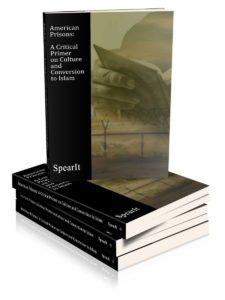Why Problems in Prison Should Matter to Us All
By SpearIt, Ph.D., J.D., Thurgood Marshall School of Law

Commenting on his book, American Prisons: A Critical Primer on Culture and Conversion to Islam.
In recent decades, the United States has been under a “lock ’em up and throw away the key” mentality when it comes to imprisonment. The U. S. Supreme Court has left the question of prison sentencing to the near-complete discretion of legislatures, while placing little constitutional constraint on how long inmates can be held in solitary confinement. This hands-off approach by the Court runs parallel to federal and state lawmaking that has ratcheted prison sentences upwards-only, making criminal sentencing in America something of a runaway train.
While American criminal justice doles out some of the harshest prison sentences in the world, there are a host of negative cultural impacts on society. Given that the vast majority of inmates are ultimately released back to the streets at a rate of over 700,000 annually, the “throw away the key” approach fails to take into account the social burden on communities to which these former prisoners return.
The overarching message of my anthology, American Prisons: A Critical Primer on Culture and Conversion to Islam, is that problems in prison are not isolated from society, and unlike the Las Vegas slogan, what happens in prison doesn’t stay in prison. Prisons are not neatly cornered off from society, but rather, are partners in toxic relationships with the communities to which ex-prisoners return. Against these sinister cultural developments, the book juxtaposes the quest for God and religious conversion. More specifically, widespread conversion to Islam over many generations has made prisons an important factor for the growth of Islam in America. The book concludes with policy prescriptions based on the notion that prison reform is not just about justice for those on lockdown, but communities on the outside as well.
One example is the serious health conditions suffered by prisoners, like HIV, gonorrhea, syphilis, and other sexually transmitted diseases. Often enough, these illnesses are spread by some released inmates when they return to their communities. Additionally, mental illness in prisons continues to be poorly treated and poses a special burden on communities when these prisoners are released. For the state, mentally ill prisoners are expensive to house, likely to face extra punishments in prison, and are likely to recidivate. As mentally ill prisoners disrupt the order of prison administration, one might only fathom the effect when released to already-stressed communities.
This work, moreover, illustrates how violence in prison often “spills” over into communities in a myriad of ways. Sometimes it is less a spill since prison gangs are notorious for orchestrating “hits” against individuals outside of prison. Gender violence in prison is another related problem that gets absorbed by communities and families, and translated into domestic sexual violence. This violence along with negative economic, political, mental, physical, and health impacts, taken as a whole, denote that prisons perpetuate keeping underclass communities, underclass.
Another critical finding is the juxtaposition of these ungodly cultural developments against the backdrop of God and religious conversion in prisons. The conversion from Christianity to Islam is a forceful phenomenon that seems to have had a positive impact on the lives of many behind bars and has helped ex-prisoners stay out of prison. With an estimated 40,000 inmates converting to Islam each year, Islamic teachings and lifestyle alterations have made prisons a central space for Islam in America.
As a direct result of Muslim living, the findings show that prisoners often experience a “double-conversion.” For many, the path to Islam may have begun with a nationalist, race-based, or other novel interpretation of Islam, yet that path later leads believers to embrace different ideologies.
This pattern of conversion undoubtedly augments the growth of traditional Islamic groups, including Sunni, Shia, and Sufi. All three major strands of Islam undoubtedly continue to grow as a result of prison ministries within groups like the Nation of Islam and Moorish Science Temple. Paradoxically, the growth of Islam in America continues to be indebted to the efforts of groups that are sometimes considered non-traditional or unorthodox, if not heterodox, by comparison.
One final noteworthy aspect of this book is its policy recommendations. The work dedicates a cluster of chapters to exploring how to correct some of these salient cultural problems. For example, with respect to religion, prison administrators should try to harness the power of religion more strategically than it has in the past and work to ensure that inmates have access to religious services, education, and training. Such activities are worthy of pursuit since they also converge with institutional goals of running an orderly prison and rehabilitating prisoners.
American Prisons answers why what happens in prison should matter to us all—because there is a symbiotic relationship between prisons and society that makes prison culture critical to the well-being of communities outside. Policymakers must gain meaningful perspective of this reality and implement more practical policies that address prisoners’ needs, normalize prison culture, and recognize that at the core, prison reform is a justice issue for communities too.